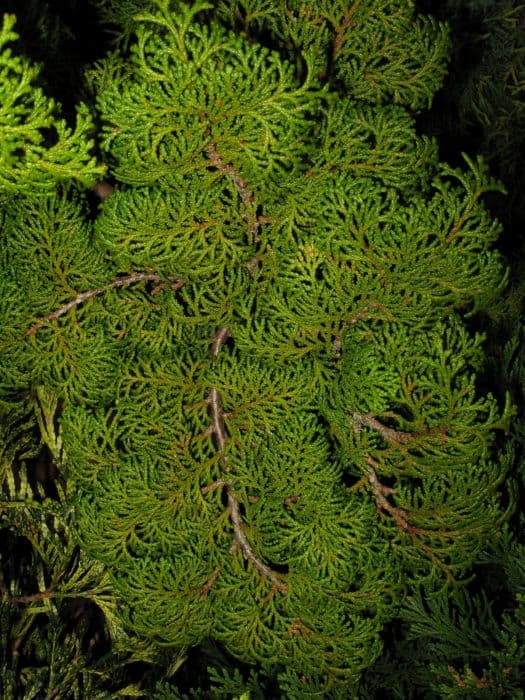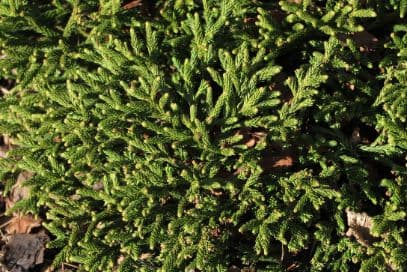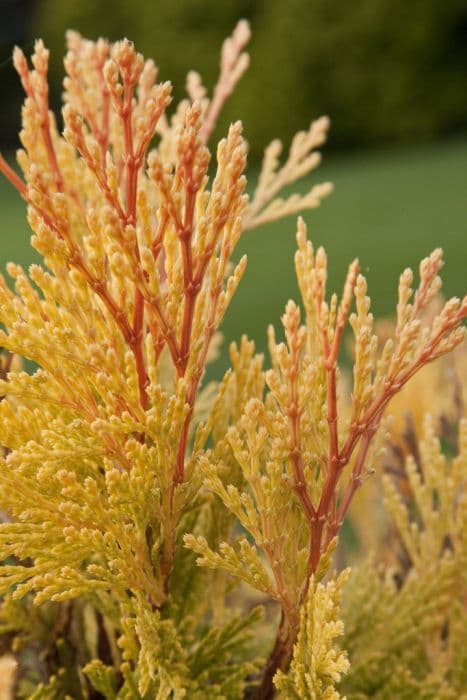Creeping juniper 'Wiltonii' Juniperus horizontalis 'Wiltonii'











ABOUT
A wide-spreading prostrate evergreen conifer forming a mat 2-3m across. Foliage blue-grey, not bronzed in winter
About this plant
 Names
NamesFamily
Cupressaceae.
Synonyms
Blue Rug Juniper, Wiltoni Juniper, Creeping Juniper, Carpet Juniper.
Common names
Juniperus horizontalis 'Wiltonii'.
 Characteristics
CharacteristicsLife cycle
Perennials
Foliage type
Evergreen
Color of leaves
Silver-blue
Height
6 inches (15 cm)
Spread
8 feet (2.4 meters)
Plant type
Shrub
Hardiness zones
3
Native area
North America
Benefits
 General Benefits
General Benefits- Ground Cover: This plant, commonly known as Blue Rug Juniper, serves as an effective ground cover, spreading across the ground and reducing soil erosion.
- Drought Tolerance: Blue Rug Juniper is highly tolerant of drought, making it suitable for xeriscaping and low-water landscapes.
- Cold Resistance: It is cold-hardy, capable of surviving in colder climates without much protective care.
- Low Maintenance: Once established, Blue Rug Juniper requires minimal care, not needing frequent watering, pruning, or fertilization.
- Pest Resistance: The plant is generally resistant to pests, meaning fewer chemical treatments are necessary.
- Ornamental Appeal: The silvery-blue foliage of Blue Rug Juniper provides year-round visual interest and color to gardens and landscapes.
- Wildlife Habitat: Though not a primary source of food, it provides cover and nesting sites for small animals and birds.
- Erosion Control: Its rooting system helps stabilize slopes and banks, preventing soil erosion especially in rocky or sandy areas.
- Weed Suppression: The dense mat of foliage inhibits weed growth, reducing the need for herbicidal use and maintenance.
- Adaptability: Blue Rug Juniper can grow in a variety of soil types, as long as there is good drainage.
- Fire Resistance: Being a low-resin plant, it is less flammable than many other plants, which can be an advantage in fire-prone areas.
 Medical Properties
Medical PropertiesThis plant is not used for medical purposes.
 Air-purifying Qualities
Air-purifying QualitiesThis plant is not specifically known for air purifying qualities.
 Other Uses
Other Uses- Juniper 'Wiltonii', commonly known as Blue Rug Juniper, can be used as a natural bird habitat, offering shelter and nesting opportunities for small birds due to its dense foliage.
- The plant's wood is sometimes harvested for use in craft projects or as part of small woodwork items due to its durability and pleasant scent.
- During the holiday season, the branches of Blue Rug Juniper may be harvested and used in wreaths and other decorative arrangements for their color and texture.
- It serves as a living mulch, as its dense growth habit suppresses weeds and helps maintain soil moisture.
- Dried branches of Blue Rug Juniper are occasionally used for creating natural dyes for fabrics and wool, with different parts of the plant yielding different colors.
- In landscaping, Blue Rug Juniper can function as a natural erosion control on slopes due to its mat-forming growth habit that stabilizes the soil.
- Some bonsai enthusiasts might use Blue Rug Juniper as a candidate for creating bonsai trees due to its interesting texture and growth pattern.
- The plant can be utilized in xeriscaping, a landscaping method that reduces or eliminates the need for supplemental water from irrigation.
- Photographers and visual artists may use Blue Rug Juniper as a backdrop or as part of a composition for outdoor photography due to its aesthetic appeal.
- It can act as a natural snow fence in colder regions, trapping snow within its branches and reducing snowdrift on roads or paths.
Interesting Facts
 Feng Shui
Feng ShuiThe Blue Rug Juniper is not used in Feng Shui practice.
 Zodiac Sign Compitability
Zodiac Sign CompitabilityThe Blue Rug Juniper is not used in astrology practice.
 Plant Symbolism
Plant Symbolism- Protection: Juniper plants have been traditionally thought to ward off evil spirits and negative energies, and many cultures use them to protect their homes and properties.
- Purity: The clean, sharp scent of juniper is often associated with purification rituals, symbolizing the removal of impurities both spiritually and physically.
- Healing: With its various medicinal uses throughout history, juniper is frequently seen as a symbol of healing and health.
- Endurance: Juniper plants have the ability to thrive in harsh, rocky soils, making them a symbol of resilience and the ability to persist through challenges.
 Water
WaterBlue Rug Juniper requires watering once a week, providing enough water to moisten the soil to a depth of around 4 inches. During the growing season, it's essential to ensure the soil remains slightly moist but never soggy. In the absence of rainfall, water with approximately 1 to 2 gallons depending on the size and the environmental conditions. During the winter months, reduce watering frequency as the plant's water requirements decrease. Always check the soil moisture level before watering to avoid overwatering, which can lead to root rot.
 Light
LightBlue Rug Juniper thrives best in full sun conditions, where it can receive at least 6 to 8 hours of direct sunlight a day. It's ideal to plant it in a spot where it can benefit from maximum light exposure throughout the day, as this promotes dense foliage and healthy growth. Partial shade is tolerated, but the plant's growth may become less vigorous and its vibrant color can diminish.
 Temperature
TemperatureBlue Rug Juniper is hardy and can adapt to a wide range of temperatures, making it suitable for many climates. It can withstand temperatures as low as -40°F and as high as 90°F. The ideal temperature range for this evergreen shrub is between 60°F and 80°F. It is very frost resistant and can survive harsh winters, but for optimal growth, avoid extremely hot and dry conditions.
 Pruning
PruningBlue Rug Juniper requires minimal pruning to maintain its shape and health. Pruning should be done in late winter or early spring before new growth begins. This evergreen is often pruned to remove dead, damaged, or diseased branches and to control its size. Whenever pruning, make sure to use sharp tools to make clean cuts without tearing the plant's flesh. Generally, light trimming annually or as needed to shape the plant is sufficient.
 Cleaning
CleaningNot needed
 Soil
SoilBlue Rug Juniper thrives in well-drained soil with a slightly acidic to neutral pH between 5.5 and 7.0. The best soil mix should have a combination of loamy soil, sand, and organic matter like peat moss or pine bark for improved drainage and aeration.
 Repotting
RepottingBlue Rug Junipers are typically grown outdoors and do not require repotting as they are spreading groundcovers. Once planted in the landscape, they do not need to be moved.
 Humidity & Misting
Humidity & MistingBlue Rug Juniper is tolerant of a wide range of humidity levels and does well in average outdoor conditions. It does not have specific humidity requirements and is quite adaptable to different climates.
 Suitable locations
Suitable locationsIndoor
Place in bright light, ensure good air circulation.
Outdoor
Full sun, well-draining soil, space plants 4-6 feet.
Hardiness zone
3-9 USDA
 Life cycle
Life cycleJuniperus horizontalis 'Wiltonii', commonly known as Blue Rug Juniper, begins its life cycle as a seed, which, once germinated, develops into a small seedling. The seedling gradually matures into a spreading evergreen shrub, characterized by its silver-blue foliage and low-growing, mat-forming habit. As it grows, it reaches its vegetative stage, where it spreads outwards through stems that root at the nodes, covering the ground effectively. The reproductive phase sees the production of small, inconspicuous flowers, leading to the development of berry-like cones called juniper berries, which contain the seeds for the next generation. These plants are generally slow-growing but can live for many years, continuing to spread and thicken, providing valuable ground cover and erosion control. Over time, older plants may become woody and less dense, eventually completing their life cycle when they die, leaving seeds that may sprout to start the cycle anew.
 Propogation
PropogationPropogation time
Spring to Summer
The most popular method of propagating Blue Rug Juniper is through softwood cuttings taken in late spring or early summer when new growth is just beginning to harden off. Cuttings should be about 4 to 6 inches long and should include several sets of leaves. Strip the bottom sets of leaves off the cutting to expose the nodes, as this is where roots will develop. Dipping the cut end into a rooting hormone can enhance rooting success. The prepared cuttings should be planted in a well-draining rooting medium, such as a mix of peat and perlite, ensuring that the exposed nodes are buried. The medium should remain moist but not waterlogged, and cuttings should be kept in a warm, bright environment but out of direct sunlight. Roots typically develop within 4 to 8 weeks, after which the rooted cuttings can be gradually acclimated to outdoor conditions before permanent planting.









